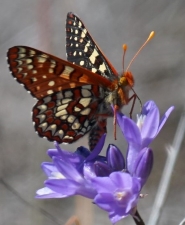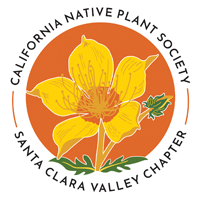California Pollinator Seed Mix
We hope you enjoy your seeds from the CNPS SCV Wildflower Ambassadors program. This plant mix provides a variety of sun loving California native annuals and perennials that sustain pollinators over a long season..
Planting Instructions
Fall through winter is the ideal time to start growing California native wildflowers as these have adapted to capitalize on the fall and winter rains (October-February is best) and bloom in spring. They may be planted through April, but after that it is best to wait until at least September to plant them as they do not do well when planted in late spring or summer.
 Choose A Site & Prepare Your Soil
Choose A Site & Prepare Your Soil
- Choose a spacious site in full sun.
- Prepare your soil (or several very large pots), by removing all existing growth and debris. If your soil is clay, break it up with some compost or cactus soil (sold at nurseries).
- Water thoroughly to help seeds settle into the soil. Continue to water a few times a week, unless it rains, so they don’t dry out after germinating. Seeds should sprout in one to three weeks.
- After you plant your seeds, let the area ‘go natural’ by leaving the leaf litter on the ground. While many butterflies go into chrysalis on stems or other hard surfaces like branches, many others go into chrysalis in the debris. If you rake or blow it, you could accidentally kill or throw them away.
Avoid using pesticides anywhere in your garden, it will kill the beneficial insects such as bees, butterflies, moths, and ladybugs that you are trying to attract. Try to ignore bugs, as they are part of the ecosystem (for instance, hummingbirds eat aphids). If you hose the plant or try to remove pests you may dislodge butterfly or ladybug eggs or kill tiny caterpillars. Avoid using herbicides as they also poison the ecosystem you are trying to nurture.
Plants In The California Pollinator Seed Mix
- Yarrow, Achillea millefolium (hosts Northern Scurfy Quaker, Olive Arches, Yarrow Plume Moth, Smeathmann's Aethes Moth)
- Mountain Garland, Clarkia unguiculata (hosts Clark's Day Sphinx Moth)
- Fort Miller Clarkia, Clarkia williamsonii (hosts Clark's Day Sphinx Moth, White-lined Sphinx, Pacific Green Sphinx Moth, Mariposa Forester)
- California Poppy, Eschscholzia californica (useful to pollinators, hosts Acmon Blue, Dotted Blue, Mormon Metalmark, etc.)Lupinus micrantha densiflorus himes crop small
Central Valley Gumplant, Grindelia camporum (hosts Orange Tortrix Moth, Cremastobombycia grindeliella) - Dense-flowered Lupine, Lupinus microcarpus var. densiflorus (hosts Painted Lady, Acmon Blue, Boisduval's Blue, Silvery BLue, Orange Sulphur)
- Rock Phacelia, Phacelia californica (hosts Oidaematophorus phaceliae, Clepsis fucana, Bilobed Looper Moth, Orange Tortrix Moth)
- Great Valley Phacelia, Phacelia ciliata (hosts Bilobed Looper Moth, Orange Tortrix Moth, Geranium Plumed Moth)
- Bolander's Phacelia, Phacelia bolanderi (hosts Bilobed Looper Moth, Orange Tortrix Moth, Geranium Plumed Moth)
- Serpentine Sunflower, Helianthus bolanderi (hosts Painted Lady, Milbert's Tortoiseshell, California Patch)
The list of moths and butterflies hosted by these plants is just a sample, these plants are a host to many more - a comprehensive list of butterflies each plant hosts, and details about the plants and butterflies, can be found at Calscape.org
*”Host” = key food source for the caterpillars of these particular butterflies, that co-evolved to specialize over thousands of years. Butterflies die out without these plants.

